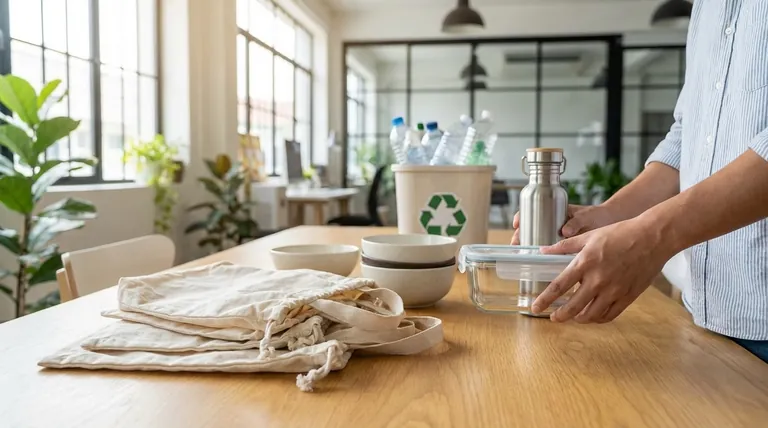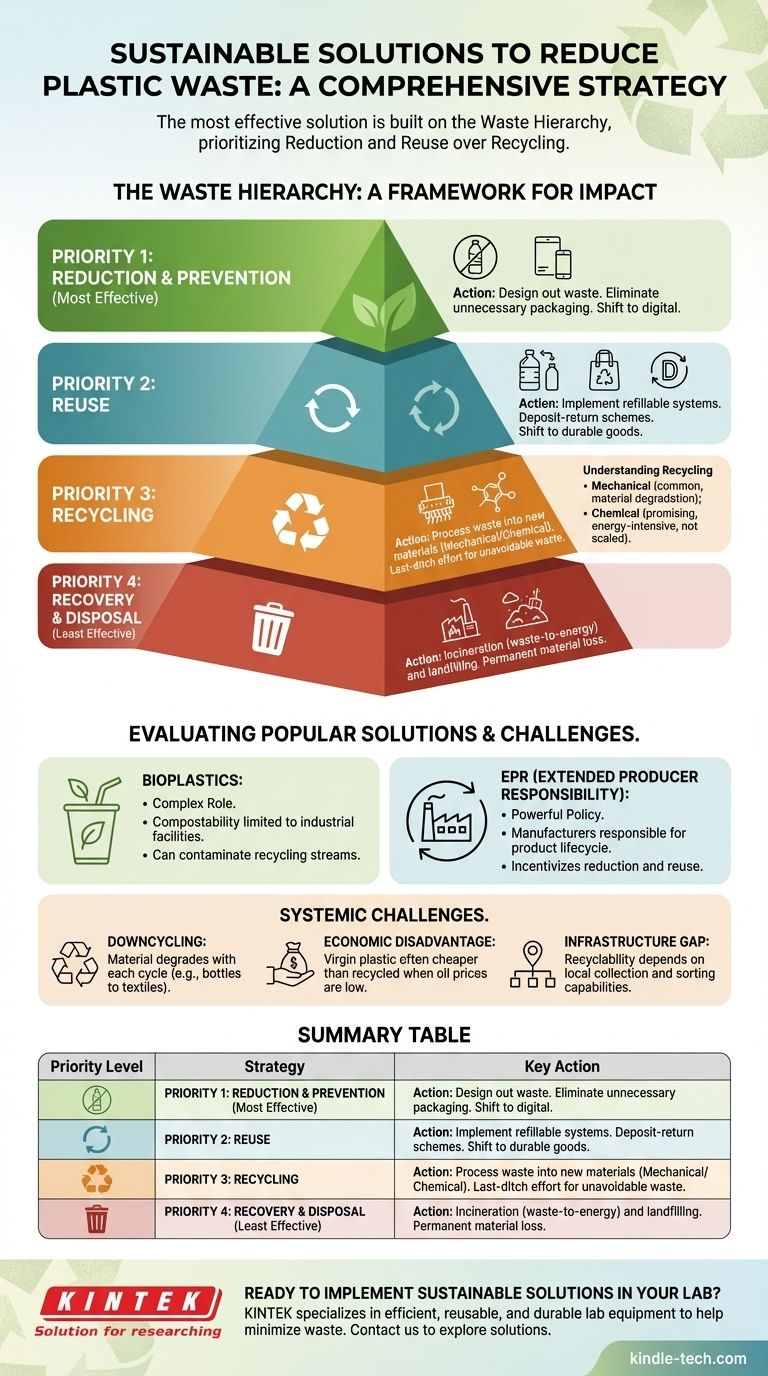Obwohl keine einzelne Technologie eine Patentlösung bietet, ist die effektivste und nachhaltigste Lösung zur Reduzierung von Plastikmüll eine umfassende Strategie, die auf der Abfallhierarchie aufbaut. Dieser Rahmen priorisiert Maßnahmen nach ihrer Umweltauswirkung und legt den größten Schwerpunkt auf Reduzierung und Wiederverwendung, lange bevor Recycling in Betracht gezogen wird. Dieser Ansatz packt das Problem an der Wurzel an, anstatt nur die Symptome zu verwalten.
Der entscheidende Fehler ist, sich auf Recycling als primäre Lösung zu konzentrieren. Wahre Nachhaltigkeit wird erreicht, indem Design, Konsum und Politik grundlegend überdacht werden, um die Notwendigkeit von Einwegplastik von Anfang an zu eliminieren.

Die Grundlage: Die Abfallhierarchie verstehen
Die Abfallhierarchie ist ein universell anerkannter Rahmen, der ein nachhaltiges Abfallmanagement leitet. Sie ordnet Abfallmanagementoptionen von der bevorzugtesten bis zur am wenigsten bevorzugten ein und erzwingt eine Verlagerung des Fokus von nachgelagerten Problemen (wie Recycling) zu vorgelagerten Lösungen (wie Prävention).
Priorität 1: Reduzierung und Prävention
Dies ist der wirkungsvollste Schritt. Der nachhaltigste Kunststoff ist der, der nie hergestellt wird.
Reduzierung beinhaltet die Gestaltung von Systemen und Produkten, die weniger Material oder gar kein Plastik benötigen. Dazu gehört die Eliminierung unnötiger Verpackungen, die „Gewichtsreduzierung“ wesentlicher Produkte und die Umstellung auf digitale Alternativen.
Priorität 2: Wiederverwendung
Wenn Plastik nicht eliminiert werden kann, ist die nächstbeste Option, es so lange wie möglich in seiner ursprünglichen Form zu verwenden.
Wiederverwendungssysteme, wie z.B. nachfüllbare Behälter für Getränke und Reinigungsmittel oder Pfandsysteme, bewahren den Wert des Materials und reduzieren erheblich den Energie- und Ressourcenaufwand, der für die Herstellung neuer Artikel benötigt wird. Es stellt eine Verlagerung von einer Wegwerf- zu einer langlebigen Denkweise dar.
Priorität 3: Recycling
Recycling ist der Prozess der Rückgewinnung von Alt- oder Abfallplastik und dessen Wiederaufbereitung zu neuen Produkten. Es ist ein entscheidender Teil der Lösung, aber aus gutem Grund die drittbeste Option.
Obwohl es Material von Deponien fernhält, hat der Prozess erhebliche Einschränkungen, darunter Energieverbrauch, Materialabbau und Kontaminationsprobleme. Es sollte als letzter Ausweg für Gegenstände angesehen werden, die nicht eliminiert oder wiederverwendet werden können.
Der letzte Ausweg: Verwertung und Entsorgung
Diese Stufe umfasst Prozesse wie die thermische Verwertung (Waste-to-Energy) und, am wenigsten wünschenswert, die Deponierung. Diese Optionen sind für Abfälle reserviert, die nicht verhindert, wiederverwendet oder recycelt werden können, und führen zum dauerhaften Verlust von Materialressourcen.
Bewertung populärer „Lösungen“ durch diese Brille
Viele vorgeschlagene Lösungen finden mediale Aufmerksamkeit, aber ihre wahre Nachhaltigkeit kann anhand der Abfallhierarchie bewertet werden.
Die Rolle von Biokunststoffen
Biokunststoffe werden oft als einfache Lösung dargestellt, aber ihre Rolle ist komplex. Einige sind so konzipiert, dass sie kompostierbar sind, aber nur in industriellen Anlagen, nicht in einem Gartenkomposter oder in der freien Natur.
Darüber hinaus kann ihre Produktion einen eigenen ökologischen Fußabdruck in Bezug auf Land- und Wasserverbrauch haben. Wenn sie in konventionelle Kunststoffrecyclingströme gelangen, wirken sie als Verunreinigung und können ganze Chargen von recycelbarem Material ruinieren.
Die Kraft der erweiterten Herstellerverantwortung (EPR)
EPR ist ein politischer Ansatz, der Hersteller für den gesamten Lebenszyklus ihrer Produkte verantwortlich macht, einschließlich deren Sammlung und endgültiger Entsorgung.
Dies ist ein mächtiger Hebel für Reduzierung und Wiederverwendung. Wenn Unternehmen die finanziellen Kosten ihres Verpackungsabfalls tragen, werden sie direkt dazu angeregt, Produkte zu entwickeln, die leichter, einfacher wiederzuverwenden und effizienter zu recyceln sind.
Chemisches vs. mechanisches Recycling
Mechanisches Recycling, die häufigste Art, beinhaltet das Zerkleinern, Waschen, Schmelzen und Umformen von Plastik. Chemisches Recycling (oder „fortschrittliches Recycling“) verwendet verschiedene Prozesse, um Kunststoffe in ihre ursprünglichen molekularen Bausteine zu zerlegen, die dann zur Herstellung neuer Kunststoffe in Neuware-Qualität verwendet werden können.
Obwohl chemisches Recycling vielversprechend für die Verarbeitung schwer zu recycelnder Mischkunststoffe ist, ist es derzeit sehr energieintensiv, hat oft geringe Ausbeuten und ist noch nicht in großem, wirtschaftlich tragfähigem Maßstab bewiesen.
Verständnis der Kompromisse und systemischen Herausforderungen
Um eine Kreislaufwirtschaft für Kunststoffe zu erreichen, müssen die erheblichen Hürden im aktuellen System anerkannt werden.
Der Mythos der unendlichen Recycelbarkeit
Die meisten gängigen Kunststoffe können nicht unendlich recycelt werden. Der Prozess des Schmelzens und Umformens von Plastik degradiert die Polymerketten, ein Phänomen, das als Downcycling bekannt ist.
Nach einigen Zyklen verliert das Material seine strukturelle Integrität und muss für minderwertigere Produkte (z.B. Plastikflaschen werden zu Textilien oder Bauholz) verwendet werden, bis es schließlich deponiert oder verbrannt wird.
Der wirtschaftliche Nachteil
Recyceltes Plastik muss mit Neuplastik konkurrieren, das direkt aus fossilen Brennstoffen hergestellt wird. Wenn die Ölpreise niedrig sind, ist Neuplastik oft billiger und von höherer Qualität als sein recyceltes Gegenstück, was einen schlechten wirtschaftlichen Anreiz für Hersteller schafft, recycelten Inhalt zu verwenden.
Die Infrastrukturlücke
Die Recycelbarkeit eines Produkts ist bedeutungslos ohne die lokale Infrastruktur, um es zu sammeln, zu sortieren und zu verarbeiten. Die Verfügbarkeit und Leistungsfähigkeit von Recyclinganlagen variiert dramatisch zwischen Gemeinden und Ländern, was zu weit verbreiteter Verbraucherverwirrung und niedrigen tatsächlichen Recyclingquoten führt.
Die richtige Wahl für Ihr Ziel treffen
Um effektiv zur Lösung beizutragen, müssen Ihre Handlungen mit der Abfallhierarchie übereinstimmen.
- Wenn Sie Produktdesigner oder Unternehmensführer sind: Ihr Hauptaugenmerk sollte darauf liegen, Abfall von Anfang an zu vermeiden, indem Sie plastikfreie Materialien erforschen und in robuste Wiederverwendungs- und Nachfüllsysteme investieren.
- Wenn Sie Politiker sind: Priorisieren Sie Gesetzgebungen wie die erweiterte Herstellerverantwortung (EPR) und stellen Sie Mittel für die Wiederverwendungsinfrastruktur bereit, die vorgelagerte Anreize zur Abfallreduzierung schafft.
- Wenn Sie ein einzelner Verbraucher sind: Ihre größte Macht liegt in der Reduzierung des Verbrauchs von Einwegartikeln und der aktiven Wahl wiederverwendbarer Alternativen, wobei Recycling Ihre letzte Option ist, nicht Ihre erste.
Eine nachhaltige Zukunft für Kunststoffe wird nicht durch besseres Abfallmanagement erreicht, sondern durch die Schaffung eines Wirtschafts- und Sozialsystems, das sie erst gar nicht produziert.
Zusammenfassungstabelle:
| Prioritätsstufe | Strategie | Schlüsselaktion |
|---|---|---|
| 1 (Am effektivsten) | Reduzierung & Prävention | Abfall vermeiden, unnötige Verpackungen eliminieren |
| 2 | Wiederverwendung | Nachfüllsysteme, Pfandsysteme implementieren |
| 3 | Recycling | Abfall zu neuen Materialien verarbeiten (mechanisch/chemisch) |
| 4 (Am wenigsten effektiv) | Verwertung & Entsorgung | Verbrennung, Deponierung als letzter Ausweg |
Bereit, nachhaltige Lösungen in Ihrem Labor umzusetzen? KINTEK ist auf Laborgeräte und Verbrauchsmaterialien spezialisiert und hilft Laboren, Abfall durch effiziente, wiederverwendbare und langlebige Produkte zu minimieren. Lassen Sie uns Ihre Nachhaltigkeitsziele unterstützen – kontaktieren Sie noch heute unsere Experten, um zu erfahren, wie unsere Lösungen Ihre Umweltauswirkungen bei gleichbleibend hoher Leistung reduzieren können.
Visuelle Anleitung

Ähnliche Produkte
- Aluminium-Kunststoff-Verbundfolie für Lithium-Batterieverpackungen
- Kundenspezifische bearbeitete und geformte PTFE-Teflon-Teile Hersteller für Labor ITO FTO leitfähiges Glasreinigungskörbchen
- Elektrischer Drehrohrofen Kleiner Drehrohrofen Biomasse-Pyrolyseanlage
- Kundenspezifische PTFE-Teflon-Teilehersteller für Reinigungsgestelle
- Wandmontierte Wasserdestillationsanlage
Andere fragen auch
- Was ist der Unterschied zwischen einer einlagigen und einer mehrschichtigen Folie? Wählen Sie die richtige Verpackung für Ihr Produkt
- Was bedeutet ein geschichteter Film? Die Tiefen des filmischen Erzählens entschlüsseln
- Was ist der Unterschied zwischen einlagigen und mehrlagigen Folien? Ein Leitfaden zur Materialauswahl
- Wie unterscheidet sich Plastikmüll von anderen Abfallarten? Die versteckte Bedrohung durch Mikroplastik
- Welche Materialien werden bei optischen Dünnschichtbeschichtungen verwendet? Schlüsselmaterialien für präzise Lichtsteuerung







